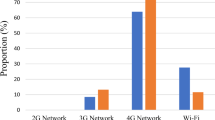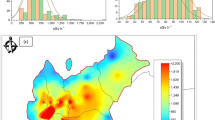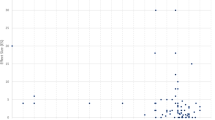Abstract
In order to achieve an integrated radio-frequency electromagnetic fields (RF-EMF) dose assessment, detailed information about source-specific exposure duration and output power is needed. We developed an Integrated Exposure Model (IEM) to combine energy absorbed due to use of and exposure to RF-EMF sources and applied it to a sample of the general population to derive population RF-EMF estimates. The IEM used specific absorption rate transfer algorithms to provide RF-EMF daily dose estimates (mJ/kg/day) using source-specific attributes (e.g. output power, distance), personal characteristics and usage patterns. Information was obtained from an international survey performed in four European countries with 1755 participants. We obtained median whole-body and whole-brain doses of 183.7 and 204.4 mJ/kg/day. Main contributors to whole-brain dose were mobile phone near the head for calling (2G networks) and far-field sources, whereas the latter together with multiple other RF-EMF sources were main contributors for whole-body dose. For other anatomical sites, 2G phone calls, mobile data and far-field exposure were important contributors. The IEM provides insight into main contributors to total RF-EMF dose and, applied to an international survey, provides an estimate of population RF-dose. The IEM can be used in future epidemiological studies, risk assessments and exposure reduction strategies.
This is a preview of subscription content, access via your institution
Access options
Subscribe to this journal
Receive 6 print issues and online access
$259.00 per year
only $43.17 per issue
Buy this article
- Purchase on Springer Link
- Instant access to full article PDF
Prices may be subject to local taxes which are calculated during checkout



Similar content being viewed by others
Code availability
The model is available upon request: R.C.H.Vermeulen@uu.nl. Version 1.2.6 was used to generate the results presented here.
References
World Health Organization. WHO research agenda for radiofrequency fields. WHO Libr. Cat. Data. 2010; p. 42.
Röösli M, Lagorio S, Schoemaker MJ, Schüz J, Feychting M. Brain and salivary gland tumors and mobile phone use: evaluating the evidence from various epidemiological study designs. Annu Rev Public Health. 2019. https://doi.org/10.1146/annurev-publhealth-040218-044037.
Cardis E, Richardson L, Deltour I, Armstrong B, Feychting M, Johansen C, et al. The INTERPHONE study: design, epidemiological methods, and description of the study population. Eur J Epidemiol. 2007. https://doi.org/10.1007/s10654-007-9152-z.
Bürgi A, Frei P, Theis G, Mohler E, Braun-Fahrländer C, Fröhlich J, et al. A model for radiofrequency electromagnetic field predictions at outdoor and indoor locations in the context of epidemiological research. Bioelectromagnetics. 2010;31:226–36.
Varsier N, Plets D, Corre Y, Vermeeren G, Joseph W, Aerts S, et al. A novel method to assess human population exposure induced by a wireless cellular network. Bioelectromagnetics. 2015. https://doi.org/10.1002/bem.21928.
Aerts S, Wiart J, Martens L, Joseph W. Assessment of long-term spatio-temporal radiofrequency electromagnetic field exposure. Environ Res. 2018. https://doi.org/10.1016/j.envres.2017.11.003.
Roser K, Schoeni A, Bürgi A, Röösli M. Development of an RF-EMF exposure surrogate for epidemiologic research. Int J Environ Res Public Health. 2015;12:5634–56.
Lauer O, Frei P, Gosselin MC, Joseph W, Röösli M, Fröhlich J. Combining near- and far-field exposure for an organ-specific and whole-body RF-EMF proxy for epidemiological research: a reference case. Bioelectromagnetics. 2013;34:366–74.
Liorni I, Capstick M, van Wel L, Wiart J, Joseph W, Cardis E, et al. Evaluation of specific absorption rate in the far-field, near-to-far field and near-field regions for integrative radiofrequency exposure assessment. Radiat Prot Dosimetry. 2020. https://doi.org/10.1093/rpd/ncaa127.
CREST. Characterization of exposure to radio-frequency (RF) induced by new uses and technologies of mobile communication systems. 2013. http://radiation.isglobal.org/crest.
Joseph W, Pareit D, Vermeeren G, Naudts D, Verloock L, Martens L, et al. Determination of the duty cycle of WLAN for realistic radio frequency electromagnetic field exposure assessment. Prog Biophys Mol Biol. 2013. https://doi.org/10.1016/j.pbiomolbio.2012.10.002.
Slottje P, Yzermans CJ, Korevaar JC, Hooiveld M, Vermeulen RCH. The population-based occupational and environmental health prospective cohort study (AMIGO) in the Netherlands. BMJ Open. 2015. https://doi.org/10.1136/bmjopen-2014-005858.
Eeftens M, Struchen B, Birks LE, Cardis E, Estarlich M, Fernandez MF, et al. Personal exposure to radio-frequency electromagnetic fields in Europe: is there a generation gap? Environ Int. 2018;121:216–26.
CBS Statistics Netherlands. CBS Statistics Netherlands. 2017. https://opendata.cbs.nl/statline/#/CBS/nl/dataset/81565NED/table?ts=1538661827972. Accessed 4 Oct 2018.
Statistik B für. Schweizerische Eidgenossenschaft Eidgenössisches Departement des Inneren EDI. 2012.
Eurobarometer S Health and food. Spec. Barom. 246. 2006.
Goedhart G, van Wel L, Langer CE, de Llobet Viladoms P, Wiart J, Hours M, et al. Recall of mobile phone usage and laterality in young people: the multinational Mobi-Expo study. Environ Res. 2018. https://doi.org/10.1016/j.envres.2018.04.018.
Berman D, Crump K. Final draft: technical support document for a protocol to assess asbestos-related risk. Report no. 9345.4-06. Washington, DC: U.S. Environmental Protection Agency, Office of Solid Waste and Emergency Response; 2003.
R Core Team. R: a language and environment for statistical computing. R Foundation for Statistical Computing. 2013. http://www.r-project.org/.
Kühn S, Kuster N. Field evaluation of the human exposure from multiband, multisystem mobile phones. IEEE Trans Electromagn Compat. 2013;55:275–87.
Funding
This project was funded by the European Union’s FP7 programme within the framework of the international project GERoNiMO (‘Generalized EMF Research using Novel Methods—an integrated approach: from research to risk assessment and support to risk management’, GA603794, 01/2014–12/2018) and by ANSES—the French Agence nationale de sécurité sanitaire de l’alimentation, de l’environment et du travail—within the CREST project (‘Characterization of exposure to radio-frequency (RF) induced by new uses and technologies of mobile communication systems’, 2013–2017). This project also received funding from the European Union’s Horizon 2020 research and innovation programme under the Marie Skłodowska-Curie Grant agreement No. 665501 with the research Foundation Flanders (FWO). Arno Thielens is an FWO [PEGASUS]² Marie Skłodowska-Curie fellow. ISGlobal is a member of the CERCA Programme, Generalitat de Catalunya.
Author information
Authors and Affiliations
Corresponding author
Ethics declarations
Conflict of interest
The authors declare that they have no conflict of interest.
Additional information
Publisher’s note Springer Nature remains neutral with regard to jurisdictional claims in published maps and institutional affiliations.
Rights and permissions
About this article
Cite this article
van Wel, L., Liorni, I., Huss, A. et al. Radio-frequency electromagnetic field exposure and contribution of sources in the general population: an organ-specific integrative exposure assessment. J Expo Sci Environ Epidemiol 31, 999–1007 (2021). https://doi.org/10.1038/s41370-021-00287-8
Received:
Revised:
Accepted:
Published:
Issue Date:
DOI: https://doi.org/10.1038/s41370-021-00287-8
Keywords
This article is cited by
-
A study of the long term changes in the electromagnetic environment using data from continuous monitoring sensors in Greece
Scientific Reports (2023)
-
Evaluation of Chinese populational exposure to environmental electromagnetic field based on stochastic dosimetry and parametric human modelling
Environmental Science and Pollution Research (2023)
-
Letter to the Editor “Mobile phone electromagnetic radiation and the risk of headache: a systematic review and meta‑analysis”
International Archives of Occupational and Environmental Health (2022)



